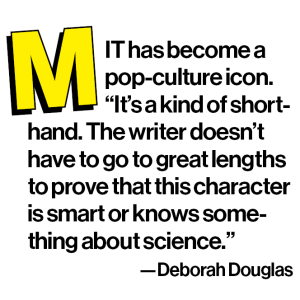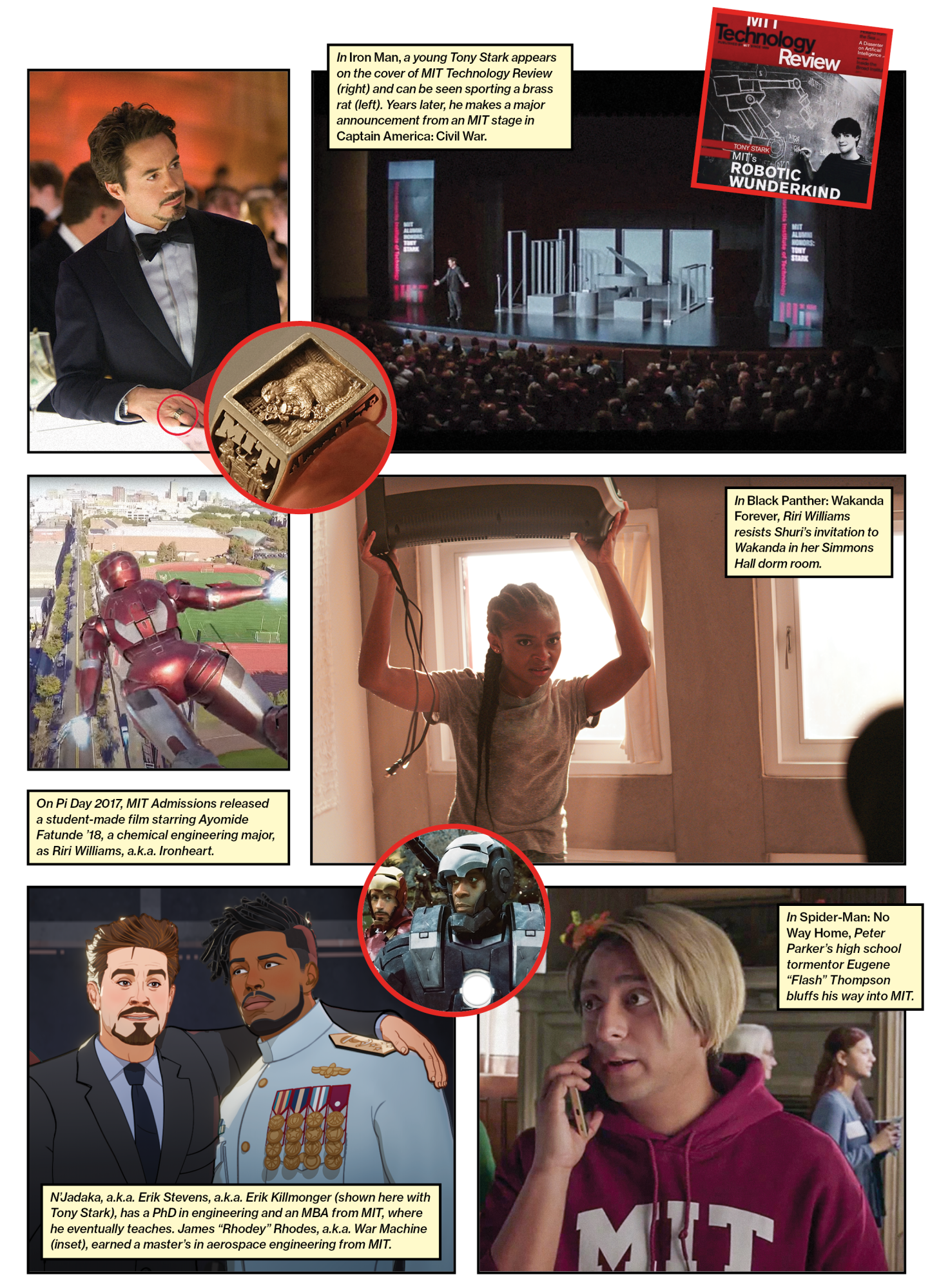Superhero U | MIT Technology Review
The brass rat Stark wears in the 2008 movie Iron Man is no coincidence. Readers of the 1996 comic Iron Man: The Legend learn that he graduated from MIT at 17 with a double major in physics and engineering—an impressive but not completely beyond-the-realm-of-possibility feat at MIT in real life. (His status as valedictorian and summa cum laude graduate, however, is of course pure fiction; the real MIT doesn’t bestow these honors.)
The Marvel Cinematic Universe (MCU) packs in multiple additional references to Stark’s MIT education. In Iron Man, a montage shows Stark on the cover of MIT Technology Review as a student, and the Institute calls on him to give a commencement speech; in Captain America: Civil War, Stark establishes the September Foundation, which funds the education of prodigies, in an MIT auditorium that looks a lot like Kresge. He also meets his best friend, James Rhodes, at MIT; both are seen wearing the iconic MIT rings known as brass rats in Iron Man. It’s likely that Marvel’s writers gave Stark an MIT backstory to make his creation of such a sophisticated full-body robotic suit seem plausible, since such technology is as yet unachievable in the real world.
How did MIT come to symbolize technological genius? While it may seem strange to ask such a question, the Institute wasn’t always as famous as it is today. “Scientists, engineers, and industrial leaders of course knew of MIT, but widespread public attention really accelerated in the mid-20th century,” says Deborah Douglas, director of collections and curator of science and technology at the MIT Museum. Doc Edgerton’s famous high-speed photos, MIT’s role in the development of radar during World War II, and the Instrumentation Lab’s contributions to the Apollo space program in the 1960s raised the Institute’s public profile, as did WGBH’s television series MIT Science Reporter in the late 1960s and early 1970s. Then media coverage of the MIT Daedalus Project, which in 1988 re-created the mythical flight of Daedalus by flying a human-powered aircraft between the islands of Crete and Santorini, “began to create awareness that extended well beyond the Boston Globe or the usual publications,” she says. “MIT had never received that kind of public attention, and it vaulted the Institute into a level of public recognition globally that it had never known before.”

As MIT has become more widely known, it has also become a pop-culture icon. “It’s a kind of shorthand,” Douglas says. “The writer doesn’t have to go to great lengths to prove that this character is smart or knows something about science, at risk of boring the audience.” Marvel in particular uses this MIT shorthand to make fantastical technology, such as arc reactors and robotic suits that give their wearers the ability to fly, seem believable. Having an MIT genius behind these creations is an easy way to explain the unexplained. That’s particularly useful for comic book writers, who need to say a lot in a few words to leave plenty of room for illustrations.
The convenience of the “MIT = genius” trope—and the popularity of Iron Man—led Marvel to create two other MIT heroes with robotic suits who recently made appearances on the silver screen.
Shortly after being unmasked as Spider-Man and accused of murdering Mysterio, Peter Parker swings into a coffee shop, a piece of mail clutched tightly in his hand, to find his friends MJ Watson and Ned Leeds so they can all open their letters from MIT Admissions together. Their anticipation fades as they read, “In light of recent controversy, we are unable to consider your application at this time.”
In Spider-Man: No Way Home (2021), Parker—a.k.a. Spider-Man—was confident that, having been mentored by Tony Stark, he had a good shot of getting into MIT. With access to Stark’s resources, Parker had gone from using homemade web shooters to designing a suit enhanced by nanotechnology. And he certainly had the academic credentials, having attended the highly competitive (fictional) Midtown School of Science and Technology and developed his skills as Spider-Man. So when he isn’t accepted, Parker launches a crusade to have MIT Admissions reconsider. The movie’s plot aligns with the reality that MIT does not consider a student’s connections or legacy status in admissions decisions. As Chris Peterson, SM ’13, of the MIT Admissions Office explained in a 2012 blog post, “There is only one way into (and out of) MIT, and that’s the hard way.”

MARVEL STUDIOS; MIT ADMISSIONS (IRONHEART); ALAMY/PICTURELUX (WAR MACHINE); SONY PICTURES ENTERTAINMENT (THOMPSON)
Another Iron Man protégé didn’t try to use the superhero’s help to get into MIT because she had already been a student there before meeting him. In Invincible Iron Man Vol. 3, #7 (2016), 15-year-old Riri Williams works late into the night in Simmons Hall, making a replica of the Iron Man suit. Much to the dismay of campus security, Riri helps herself to property from a robotics lab, skips classes, and draws several noise complaints for her work. To avoid repercussions, she flies off in her suit, meets Iron Man, and earns the moniker Ironheart. In real life, Marvel arranged to temporarily close Massachusetts Avenue in 2021 to film several scenes—including some with Riri—for Black Panther: Wakanda Forever. The character is slated to have her own show on Disney+, but the timing of its release is uncertain, given the strikes in Hollywood.

